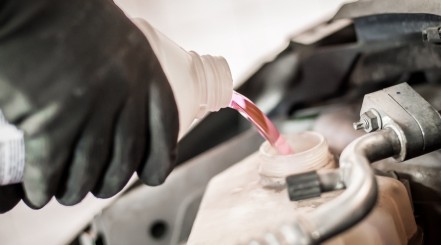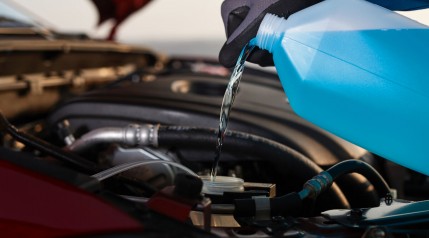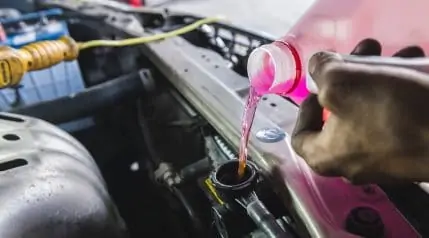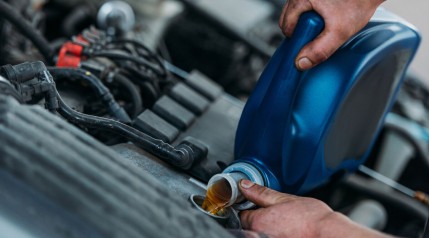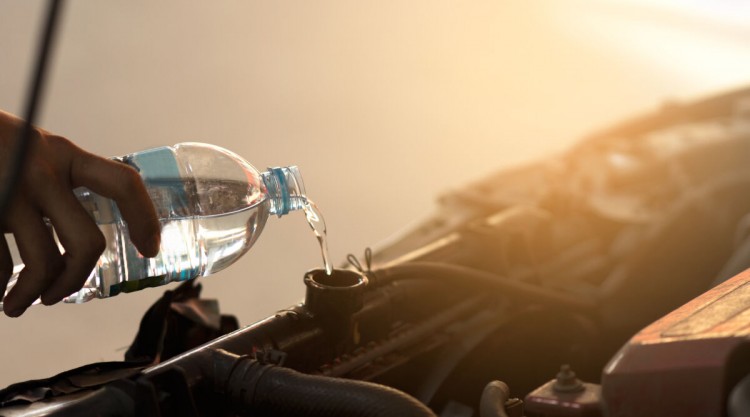
Those of us with a background in automotive care and repair are asked certain questions on a regular basis by friends, family, and strangers who learn how we earn our bread. One of the most common of these is: “can you use water as coolant?”
It transpires that most folks are aware that engine coolant goes inside the car radiator, but many are unsure whether or not you can just pour some tap water in there instead.
Engine coolant, which is also known as “antifreeze,” prevents the liquid in the car’s radiator from freezing and cracking in the winter. It also helps to lower its temperature in summer and prevent it from boiling over.
The presence of engine coolant is a year-round necessity to protect your engine’s cooling system. Without it, your vehicle’s engine will overheat, and many car parts can suffer damage. It is the most essential liquid for the health of your vehicle after engine oil.
In this article, you’ll learn what coolant is, why H2O is a good or bad substitute, and all about the different available variations of engine coolant.
Contents (Jump to Topic)
Key Takeaways
All About the Antifreeze – Antifreeze is a liquid that regulates the temperature of your engine (rather than just prevent it from freezing!). “Coolant” simply refers to a mix (usually 50/50) of antifreeze plus distilled H2O.
Water Is Damaging – Using water as coolant can cause corrosion, cracks, or overheating in your engine, all of which can result in a hefty repair bill.
The Exception to the Rule – Fluid is required to prevent your engine overheating, but you should only add water alone when you find yourself in an emergency with no antifreeze to hand.
What Is Coolant/Antifreeze?
Antifreeze is a liquid pumped around and used to remove heat from a system. In the case of a car, it’s used to regulate the temperature of the engine.
There are different types of antifreeze, which are specifically designed for different engines.
Let’s take a look at these in more detail below (and you can also check out our guide here to the best antifreeze on the market.)
Different Types of Coolant
Their color differentiates the below variations of antifreeze. Each color has a different purpose behind them. It’s not just to look more appealing.
It’s essential that you use the variation that’s best suited to your vehicle, so take note!
These are the 3 different types:
- Inorganic acid technology (IAT).
- Organic acid technology (OAT).
- Hybrid organic acid technology (HOAT).
You need to know which type to use for the optimal performance of your car engine.
We discuss these below, but here is some advice, no matter what type you are using:
- Don’t change the type of antifreeze without consulting your car user manual.
- Do not mix different types. Instead of boosting their properties, this will likely result in poorer performance.
- Antifreeze is concentrated. You’ll need to mix it with equal parts of distilled water. Usually, the ratio is 50/50, but in very cold climates you may require 60% or more.
Category 1: Inorganic Acid Technology (Iat)
This type of antifreeze is usually bright green and used in older cars. Models from the 1920s to before the mid-1990s will require this version.
IAT needs to be changed every 30,000 miles or 2 years, whichever is sooner. It has anti-corrosion properties to protect metal parts such as the radiator and engine.
Category 2: Organic Acid Technology (Oat)
The color of OAT can range from orange to dark green. It is the most common and popular type, found in most newer cars worldwide.
It contains corrosion inhibitors and additives to prevent the formation of rust.
OAT lasts much longer than IAT coolant. You’ll need to flush it out every 150,000 miles or 5 years, whichever comes first. Here is a guide on how to change your engine coolant.
Category 3: Hybrid Organic Acid Technology (Hoat)
HOAT is usually yellow or orange. It was specially created for new cars and is a mix of the other two. It has additives for greater aluminum protection and prevention of rust.
As with OAT coolant, it will last for 150,000 miles or 5 years.
Dangers of Antifreeze
Beware when handling antifreeze; it’s toxic if ingested. It contains ethylene glycol, propylene glycol, and methanol. They don’t sound like things you want to be inside your body, do they?
Be especially careful to keep it out of reach of children. Antifreeze comes in different, bright colors, can taste sweet, and a child could mistake it for kool-aid and drink it if left unattended.
Comparing Antifreeze to Water
We’ve seen why we need antifreeze and looked at the different types available on the market. But what if we’re in an emergency where we have nothing but H2O to hand?
Can we use tap water or bottled water as coolant? What will happen to our car if we do?
First of all, let’s compare the two. There are three main factors we should consider.
Boiling Point
The operating temperature of any vehicle is higher than the boiling point of water. What does this mean in terms of your radiator?
Simply put, if you don’t use antifreeze, your engine will almost surely overheat, and the liquid will evaporate and boil over. You will be forced to stop, let the engine cool off and keep adding liquid to your radiator often. Just take care when removing the radiator cap, which may be scalding hot.
Freezing Point
If you live in a very cold climate, the opposite will happen.
If you don’t add antifreeze to your radiator, it will freeze. This will cause the radiator to crack. You definitely want to avoid using just H2O at very low temperatures.
Corrosion Issues
Water contains a lot of different minerals. Over time, these will form deposits in your radiator that will prevent it from working properly.
Also, water is corrosive to metal and helps rust to form. Both corrosion and rust are deadly to your engine and parts like the cylinder gaskets, belts, radiator, and water pump, which is why antifreeze has several additives to prevent their formation.
Distilled H2O, on the other hand, is free from any residue. This is why it’s used in combination with antifreeze. Coolant not only changes the freezing and boiling point, but it also creates a protective layer on metal parts.
Your radiator and engine will last much longer using the proper antifreeze. This is why coolant (aka “radiator fluid”) is the second most crucial car fluid after engine oil.
So, Can You Use Water as Coolant in Your Car?
Now we’ve seen how important antifreeze is and how different H2O is, let’s finally answer the question:
Can you use water instead of antifreeze?
We’ve seen why H2O from the tap is never a good idea for your radiator. But, what if you’re in an emergency situation?
Let’s say you realize the antifreeze level is dangerously low and you have nothing but water in your car. You’re also far from any service station or shop where you can buy some. What do you do?
Heed the advice in this video about putting water in your radiator:
Pros of Using Water Instead of Antifreeze
In an emergency, it will still be better than driving without ANY liquid in your radiator, or with very low levels of it. This would cause engine overheating, and if you still kept driving, huge damage to many car parts.
However, this is only a temporary solution until you can get to a repair shop or service station.
The best coolant mixture for your car’s coolant system and general health is a 50/50 mix of distilled H2O and the right type of antifreeze, and this isn’t up for debate!
Cons of Using Water Instead of Antifreeze
You cannot drive for too long topping up your radiator this way. If the engine overheats, make sure to stop and let it cool off.
Some modern cars even have a shut-off system that prevents the engine from overheating to dangerously high temperatures, which is a particular risk in hot climates. It will shut down your engine and will not allow you to turn it back on until it is cool enough to run again.
How Far Will Water Take You?
How many miles you can drive relying on just H2O and no antifreeze will depend on weather conditions, the vehicle model, and where you are driving.
The less you stop and go, the slower your engine will overheat. For example, on a highway with smooth traffic flow or a quiet country road without many turns.
Mild weather is a better scenario for using water instead of coolant. We’ve seen that extreme cold or hot temperatures aren’t helpful in this situation.
Also, don’t drive fast, but cruise and be gentle with your engine. The less you stress it the longer you will be able to drive.
If you’re on a long trip, don’t try to complete it with only water in the radiator. As soon as you can, get your hands on a suitable antifreeze and add it to the coolant reservoir.
Bear in mind that using water instead of a proper coolant is only an emergency fix. Water will eventually cause your car’s cooling system to rust and may even crack the engine block.
Final Thoughts
To summarize, if using water instead of engine coolants:
- You can use it instead of coolant, but only in emergencies.
- Never use it if the outside temperature is really low.
- The engine will tend to overheat with it, so don’t stress the engine too much.
- Drive slowly, cruising at the same speed, and not for too long.
- If the engine overheats, stop and wait for it to cool off.
- If you need to, add more before driving on.
Generally speaking, H2O isn’t good for your radiator or engine and should only be used in emergencies. This is until you can find and add the correct coolant.
So now you know what engine coolant/antifreeze is, why it’s vital to your vehicle, and how it helps your engine last much longer. Ensure that you always use the correct version that fits your specific vehicle.
Have any of you had to substitute for antifreeze? If so, what happened? Let us know in the comments section below, and feel free to ask us if you have any additional questions. And if you found this post useful, please feel free to share it on social media!

